This post contains affiliate links.
About a month ago, I had the pleasure of checking out Vogue Knitting Live with a press pass. I actually recorded three different interviews at the event, and I’m pleased to share one today.
Joan McGowan-Michael is the designer behind White Lies Designs. In addition to her extensive collection of (mostly) knit (with some crochet) designs, she is also a nationally recognized knitting and crochet teacher and author, and has appeared on Knitty Gritty and Needle Art’s Studio with Shay Pendray.
You can find Joan online on her website, blog, Facebook page, Etsy shop, and on Ravelry (as whitelies and on her designer page). All images are used with her permission, and link back to the patterns. Unless otherwise noted, images are (c) White Lies Designs.
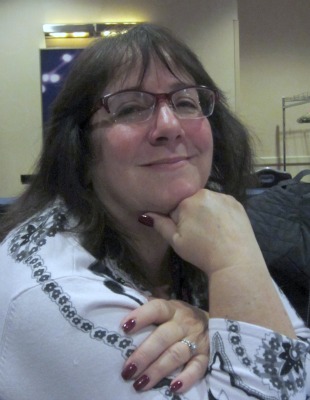
Underground Crafter (UC): How did you get started knitting?
Joan: I was taught to knit as a child, to keep me busy and out of trouble. I’ve been knitting for over 40 years.
UC: You don’t look it!
Joan: Thank you. Thank you very much. But I have. I was not horribly young, not kindergarten age, but, in the first grade, second grade and I was very fascinated by it. My mom, however, had very little patience for certain things. She taught me how to knit but not to purl. She taught me how to cast on but not how to bind off. I was just dying to get into it, so I would just invent these ways to finish off things.
It’s really interesting. I recently cleaned out my parents’ house and found a little shoebox of some of the little doll clothes I made. And the little vests started ok from the bottom, but as they got towards the top I just ran thread through the loops! It looked a little weird but it worked.

And the other thing that was interesting is, at the time, in the ’60s, those big window pane vests were kind of hip, with the big holes in them. I was dying to make one of those for my dolls, but did not know how to do a yarn over. So I had to figure out how to make a hole in the fabric that wouldn’t run. What I came up with was knitting each stitch 3 times and then moving to the next stitch – passing it back and forth, almost crocheting. This made a nice little hole. So I found these things and I went, “I remember how I did that. That was kind of clever.” I tried it up again and so I sell stockings now – fishnet stockings – using the mind of a 7 year old or an 8 year old that made up this stitch. I’ve never seen this stitch anywhere else.
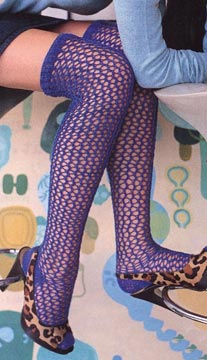
UC: It’s true, we have the ingenuity to figure things out. Before there were stitch dictionaries, people had their own ways of making it happen.
Joan: They got where they wanted because they wanted to get there.
UC: Yes, through trial and error. How did you first get started designing?
Joan: I actually went to fashion design school. I had always been fascinated with fashion design. I was one of those people that knew what they had to do with their life. To me, it’s very strange when you have a person that’s an adult and says I don’t know what I want to do with my life. I knew, always, what I wanted to do. That must be an odd feeling, to not know.
In any event, I was always making my own clothes and when I got to college level, I did Costume Design. They have very good pattern drafting classes and you get to do weird shapes if you’re costuming plays, or super intricate historical things. A lot of what I’d learned previously was confirmed when I was in design school – that this was the right way to do things.
I did go to the Fashion Institute of Design and Merchandising in San Francisco and took a couple of years there and then went to Los Angeles and took my last year in Los Angeles. I then stayed in Los Angeles for the next 15 years doing regular clothing design.
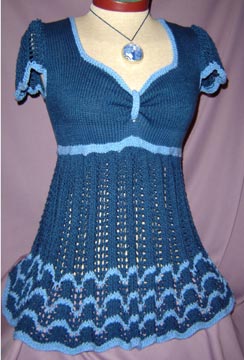
I had done work for OP Sunwear and others, but the most important was Frederick’s of Hollywood. I worked for them for three and a half years. That’s really where I got my hands into stretch fabrics, and close to the body type garments, and realized that knitting and stretch fabrics had so many of the same properties that you could almost interchange them. So I filed that away in my mind for later use. There was no knitting career on the horizon at that time.
Things happened, I got married, moved north to Sacramento with my husband, and was really having trouble settling into the city up there. It’s a different vibe and you really have to try to integrate yourself. I can imagine New York’s not that way, but it is in Sacramento. So I joined the local knitting guild there and found it to be rather cliquish and really also hard to integrate into. I said, “Maybe this is a mistake.” But before I left that first meeting, somebody shoves a little notebook at me and says sign up to bring cupcakes sometime during the year. So, I turned to the last page (December) and I write my name in December and I close the notebook and I forget about it.

December rolls around and I get a call, “It’s your turn to bring the cupcakes.” Oh, crap.
UC: To those people? 😉
Joan: Exactly. I could just blow them off or I could do some boxed cupcake mix and drop them off and come back home. It wasn’t that far from where I lived, so I thought, yeah, I’ll do that. So, I make the cupcakes and I go down there. The speaker that month was a woman who was putting together a company to do knit kits. She was doing marketing surveys. She was showing people a Vogue Knitting magazine and asking if this is something you would make, and if you were going to buy a kit, how much would you pay for it, and what would you expect from the kit.
As she was talking about this, I got this hot feeling, this freaky hot feeling. It’s the finger of God coming down and going, “You need to go this way, young lady.” Before I knew what I was doing, I went up to her and said, “I need to offer you my services as a designer. I don’t design knitwear but I do design and I do knit. That must mean something!”
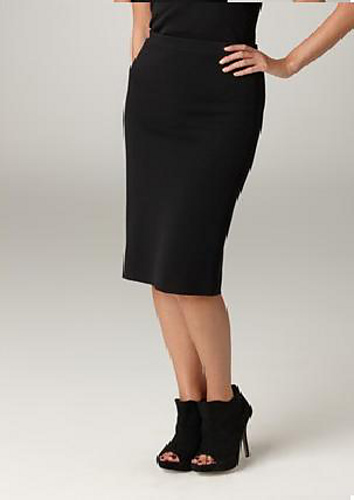
And sure enough, it did. And the first sweater that I did for that knit kit company was fantastic. It had bobbles, it had cables, it had lace, it had button bands, a high collar. It had everything. It was angora.
UC: You put all of your years of knitting experience in one sweater.
Joan: I did! I really did. And forgot to take any notes.
UC: Oh, God!
Joan: It was really hellish. Through tears and fire, I recreated the pattern somehow and it was just hellish. But it became their best selling item. They had me under contract for about two years. During that time, I found the hole in the contract. It said what I could not do, but I saw what I could do. What I could do was submit designs to magazines and that’s what I did. I submitted something to Interweave Knits. The first thing I submitted was on the cover.
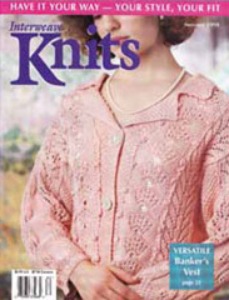
UC: Wow.
Joan: So I knew I had something going on there. In the meantime, the other people who I was under contract with were not very happy about me finding the loophole.
UC: They wanted you exclusive?
Joan: They wanted me exclusive or first right of refusal. The suit that I did was on the cover of Interweave and my boss saw it.
UC: It would be a little hard to hide it.
Joan: It was. It was hard to hide. Especially when you’re in that business. I just didn’t think I needed any permission to do anything like that. I did not like the way it went and I terminated my contract a little early with them.
So anyway, it was fine. I went on to do a few more things for magazines. By that time, I’d become divorced and my new boyfriend said, “You know, if you would like to start some kind of a little publishing thing, you have some designs here, you’re writing them anyway. Why don’t we publish them for you and sell them yourself? Why sell them off to a magazine?” The man has vision and that’s why I married him!

UC: Sounds like a good business decision.
Joan: It really was and that’s really how we got started. He works with me in the business now. We travel and do shows like STITCHES and Vogue Knitting Live and whatnot, and it grew into a business from there. I took a lot of the experiences and things that I’ve done previously.
For example, when I was at Frederick’s of Hollywood, I just had the foresight to trace off the patterns that I was cutting on brown paper and just archive them – keep them in a big box, kept them with me whenever I moved, kept them in the attic. Then came the opportunity to do my book, Knitting Lingerie Style: More Than 30 Basic and Lingerie – Inspired Designs. Melanie Falick at Abrams publishing, she had heard in an interview from me somewhere that I did used to work for Frederick’s of Hollywood and she said would you like to do a book about lingerie?

UC: That was going to be my next question. How did you get into the lingerie?
Joan: There it is. I went up to the attic, and got my big box down, and said, “Well this would work! This would work, too.” I had really the basic pieces all there. It was just a matter of transfering them to knitting – knitting the shapes instead of cutting them out of fabric – and assembling them like I would have if I had cut them out of fabric. Consequently, I was able to use a bra wire that I had designed when I was working for Frederick’s. It was a w – a continuous underwire.

UC: Wow, one piece?
Joan: Yes, the reason I designed it that way was I always have my wires popping either in the center or at the side.
UC: Yes, I think everybody has that problem. Well, not everybody, but most of us with the regular bras.
Joan: With the big boobs.
UC: The combo!
Joan: Well, the weight of them makes them float around inside their channeling. And the w wire stays right where it is. The breasts are holding them in place, then you have this v coming up in the center, they can’t go anywhere. This is just the perfect wire for long wearing bras. Don’t know why I don’t see it more.
UC: I don’t know either, I would love to see this more because I have the same exact problem!
Joan: So anyway, we went into that project using so many of the ideas from Frederick’s, but my dear editor kept me from doing sequined pasties or anything like that. She let me do a few things that were a little on the risque side, but for the most part she kept me under her thumb and on the right side of the line of good taste.
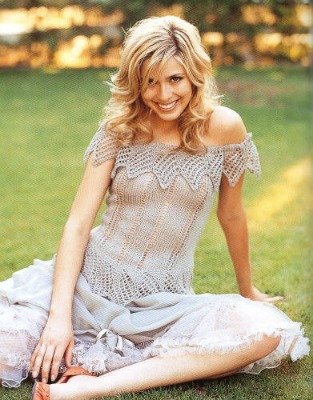
UC: Can you just talk a little bit about what you’ve been doing here at Vogue Knitting Live?
Joan: I’ve done a Crochet for Knits class. It’s very interesting. My classes that people choose sometimes have nothing to do with knititng. One of my most popular classes – unfortunately, we didn’t do it here this time since we didn’t have room in my schedule for it – is Whip Your Knits into Shape. What we do is take copious measurements of the student’s body and then we transfer those to brown paper. Now we have an actual flat pattern.
UC: Kind of like a sloper?
Joan: Yes, a sloper. And then, without having to know anything about pattern making, they can just start knitting. If they’re knitting the back of a sweater, compare it. Oh, too big, I’ve gotta rip back. Before you get finished, you know it’s fine.
The other thing, I do a 6 hour class of Whip Your Knits into Shape where we take those measurements, do the brown paper patterns, and then we learn to design with them. It’s a really very popular class and a lot of poeple have had their aha moments. When they’re in the class saying why doesn’t this fit me – well, you can’t see yourself from the back.
UC: Absolutely, you don’t see what’s going on back there.
Joan: Too many people don’t want to know, either. The other classes that we’ve done this time was Bead Embroidery for Knits which was based on my little collection of 1950s beaded sweaters. I have 4 or 5 pieces that have fabulous beadwork on them. There was one in particular that I took and made into a chart and we just copy that essentially and I teach them how to do the beadwork without having to do it one by one by one.
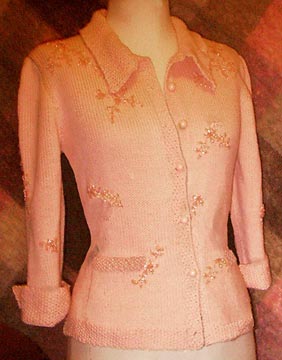
UC: Oh, that’s awesome.
Joan: It’s not done that way. They can take that skill and use it for Christmas ornaments or decorating clothes, t-shirts, jeans jackets. I’m a child of the ’70s, it’s going to be my flares, man! It’s a very fun class for everybody and it has nothing to do with knitting – you can do it on anything.
The other class, Crochet for Knits, is fine finishing touches that you can use for your knitting, to keep edges from rolling, to be decorative, to join things together, just learning how to handle a hook when you’re a die-hard knitter. They’re a little afraid of that.
UC: Yes, it’s interesting because people are always saying crocheting is so much easier. But I’ve found, now that I’ve started knitting, that a lot of knitters are really intimidated by crochet.
Joan: Very. You should have seen the big eyes in my class.
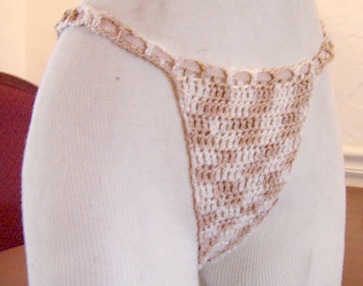
UC: So what do you do to put them at ease because I know crochet’s a phobia for a lot of knitters.
Joan: We just jump in. I ask them how do you hold your hook? Some hold it like a spoon, some hold it like a pencil. And as soon as I start requiring them to use it, they do. They just do because they have to. I have them do a chain with their fingers first so they can get the structure of the stitch and then stitch the hook in and continue. Now they’re getting comfortable and we can roll from there. It’s just getting them comfortable and not afraid of the hook. And you can rip it out so easy! They go, “Hey, there’s only one stitch at a time that you have to worry about!”
UC: That is a huge plus of crochet.
Joan: It’s quite a revelation.
UC: Yeah, when you’re knitting and it’s really stressful to do that (pull out stitches). Since you also crochet… I’m sure you have not too much down time when you can actually make your own projects, but if you do, do you have a preference between crocheting or knitting? Or do you have a totally other craft that you do to relax?
Joan: You know, I would love another craft. That I use to relax? I do sew. And I have to sew, because I’m a hard fit. So I do sew and I make things for myself on the sewing machine. And after so many years of knitting, sewing seems so easy and fast! Instant gratification. Putting a pair of pants together – no sweat. Lining a coat – not a problem. Things that would have been really daunting before, now that you put three weeks into a sweater, I can put ten hours into a coat – that kind of thing. I guess I want to say sewing is my other, non-professional hobby.
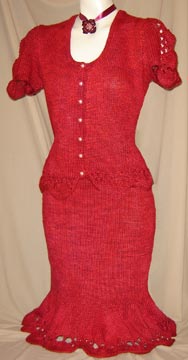
UC: It sounds like it’s also utilitarian – it’s not just for fun.
Joan: Sometimes it is. Sometimes I just want something knew and I just whip up a little knit top or something. I also do machine knitting and sometimes I will combine that with fabric and sewing things together. It’s kind of automated – it’s not hand knitting – and it’s very fast. You can do a front or back of a tank top in literally twenty minutes. That’s really instant gratification. Yep, sewing is pretty much the other white meat there :).
UC: You’ve had a lot of experience in all different aspects of the yarn industry and the fashion industry. Do you have any advice for people that are considering trying to come into the yarn industry?
Joan: Boy, keep your day job. At this moment, keep your day job. Didn’t use to be that way, but things got really rough here for the economy. Putting out a few patterns may or may not be something that becomes viable, but the main advice is have somebody read your patterns. Tech edit your stuff or test knit your stuff. A lot of people maybe have done that for themselves, and they can’t see the forest for the trees anymore when they are working with their own pattern. There’s just nothing more off-putting then buying a pattern from a new designer and finding it not working. To keep your reputation good, take that extra little step and have somebody read it, tech edit it, something. That’s really one of the most important things, I think.
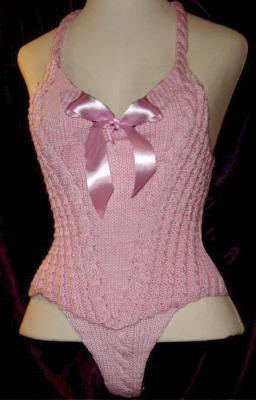
UC: Do you have any upcoming activities you’d like to talk about?
Joan: Yes, I’m going to be doing some classes on Craftsy in the upcoming months. I’m actually looking for Stephanie Japel today because she’s the acquisitions editor there now. I will definitely be doing a Continental Knitting class, which may be one of the free ones. It just introduces you to the teacher and how their teaching style is, but there will also be others on fit most definitely. So look for me in about four or five months on Craftsy. (UC comment: You can now find Joan’s Feminine Fit: Bust Shaping Techniques class for sale on Craftsy here.)
We always do STITCHES West at the Santa Clara Convention Center. I always have a booth there, so people can come by and see the garments that I do in person. I’m about to pitch another book. I’m not going to say what it’s about, but it’s along the lines of Knitting Lingerie Style, so it’s more romantic, kind of sexy, pretty things.
UC: Good luck! More pretty stuff is definitely needed. Anything else you’d like to share?
Joan: I also have a pretty good blog. I’m running a fitting series which started last Monday (UC comment: on January 14, 2013), so anyone can go to my blog and check out the first installment of Knit to Fit. I wrote about the five different mistakes knitters make in terms of fit. I’m going to expand that because the reaction to that has been really positive. I’ll possibly do an e-book with that.
UC: There’s a lot of fears and concerns and horror stories surrounding knit fitting – and crochet fitting, too.
Joan: And wasted money and disappointment. I’m all about avoiding disappointment, especially when you’re working on something you think you’re going to love, and then you put it on and go, “Oh, that looks awful!” If I can help anybody avoid that, I’m all over it!
Thanks so much, Joan! I really appreciate you taking time from your busy schedule at Vogue Knitting Live to meet with me!


